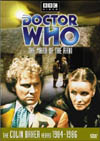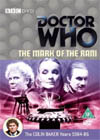DVD Extras include:
Proper Interaction"The Mark of the Rani" valiantly tackles both of the major story structure problems of this season, conquering one better than any other story this season, and achieving a bit of a truce with the other. I will continue to automatically refer to the 25-minute international versions of this season's episodes, especially since it really highlights these challenges in the writing.First of all, it's just great to see the Doctor and Peri get one quick scene in the TARDIS, and then come out to the scene of the main action so fast. It takes a bit more time for them to begin interacting with the guest characters, but they get quite good interaction and lots of it before the first half-hour episode is over. Great stuff. "Attack of the Cybermen" (story no. 138) may have disguised its lack of opening interaction for the Doctor and Peri excellently, but "The Mark of the Rani" has conquered this problem much more directly. We should also note that the guest cast is full of good, understandable, normal people that the Doctor can get on side with and try to help. This may seem a simple consideration, but it's surprising how often other stories of this era can forget to connect with this important element of the heroic template. Lord Ravensworth leads the charge in this area, being the chief screen presence for intelligent local folk. The more historically famous George Stevenson takes a bit of a back seat, not featuring in the first half, and later suffering a similar lack of initial close-ups as Mike Yates endured during his first appearance in "Terror of the Autons" (story no. 55). It's also nice to see so much location film being used all through this story, and to see director Sarah Hellings taking advantage of that method of working to get a lot of really creative and exciting sequences for the adventure. Good stuff. The 25-minute Part One ends in a good place, with the Master's investigations having just revealed the Rani and begun to pique viewer interest, but the arbitrary "cliffhanger" itself has no teeth. The Master says, "I'm indestructible; the whole universe knows that," to which the Rani smugly replies, "Is that so?".... and off to the credits we go.
Motivating Rogue TimelordsIndeed, the Master upstages the Rani at nearly every turn in this story, especially in the second half-hour episode. Fans and viewers probably have split opinions on whether or not this should be so. The Master seems pretty well motivated in this one, focusing on the ambitious plan side of things, but having run out of his own completely original ideas, he follows the Rani looking for fresh inspiration, which he finds. Perhaps it is a bit strange that he has no need to try to recover anything that he has lost, considering what happened to him at the end of the last story - something which receives very idle discussion in this tale that tells us nothing. His vengeful sparring with the Doctor is present though, and thanks to the Rani's comments, clearly painted as one of the Master's biggest Achilles' heels.As another rogue Timelord, or Timelady, the Rani could easily have all the same typical motivational challenges as the Master, but I think writers Pip and Jane Baker have successfully differentiated her, elevating her scientific curiosity above her ambitions and her morality. Nice twist. She is working to regain something she lost due to her ambitions on Miasimia Goria. After meeting the Master, her ambitions go up another level. All good. Even better, she has no taste for revenge on the Doctor, believing it a foolish gesture. Nice. She doesn't quite appear to have her lifestyle figured out any better than the Master though. While being the ruler of an entire planet, she sneaks around alone in disguise in a drudgery-filled period of our history, processing a small number of humans at a time to help what we assume to be the entire population of her own world. Could she not have delegated some of the work? Or is she just that obsessed with enjoying the scientific experimentation of it all hands on?
The Logic of the EscalationsThe premise of the story clearly belongs to the Rani, and our second 25-minute episode is well-occupied by having first the Master and then the Doctor investigate and expose her plot, escalating tensions and conflict between all three Timelords until a really good, unique cliffhanger is delivered.Part Three proceeds to develop some good plans for escalating to a new, more ambitious plot. There's a very nice sequence of the Master using Luke Ward to keep Lord Ravensworth and George Stevenson from putting their heads together and hampering the new plan. We also make up for the fact that we neither see the Doctor's TARDIS materialize at the beginning of the adventure, nor encounter the Master's TARDIS at any point, with a superb sequence of the Doctor discovering the Rani's TARDIS and going for a ride in it. However, the logic of the story is starting to dissipate. Why would the Master and the Rani abandon the room in which her TARDIS sits and crawl into the mines, just to bring her TARDIS to the mines by remote control so they can gather more resources from it? At any rate, Part Three still works, maintaining mystery and leaving many important elements of the plot unresolved for the final 25-minutes. Again, the cliffhanger itself doesn't grip. The Doctor does a double-take on Luke Ward, suspecting something isn't quite right with him, before dashing out of Ravensworth's office. Peri and Ravensworth stand agape, with Ravensworth saying, "Well, now where's he off to?", followed by another clumsy cut to the credits. Less than ideal. Having read the novel first, I had assumed the cliffhanger would have been the first demonstration of someone stepping on one of the Rani's booby traps and turning into a tree. Yes, a better cliffhanger, but that would have made the structural mistake of seeing both of our lead villains subdued at gunpoint by the hero already. Though Part Four contains a number of tense sequences and decent challenges, the logic that leads from one story beat to the next isn't all that well thought out. Our villains' plot should be all about controlling the guests of Stevenson's meeting, but has instead become obsessed with finishing people off at random in Redfern Dell, and it makes absolutely no sense for the Master to want to bring Stevenson to this fate, or for Luke Ward to want to bring Peri to it. Plus, we can count the Rani as hypocritical in calling the Master "devious and overcomplicated" if this is her best plan for getting the Doctor out of the way. Who's getting dizzy trying to walk in a straight line now?
Lost in Redfern DellPart Four does deliver a lot of unique sequences, particularly in dealing with the traps in Redfern Dell, nicely using the location filming to excellent effect. Structurally, I think these bits should have come sooner, while the Master and the Rani remained free to forward their plans for the meeting and setup the story beats that should have concluded the adventure.Indeed, with the Master and the Rani spending so much time at the Doctor and Peri's mercy, and settling for a quieter ending of tricking the villains off the scene (the most definitive part of which was set up in the previous 25-minute episode) this story ends up finding its way into similar anti-climactic territory as the endings of most of its neighbouring season 22 stories. However, with the Doctor being uncharacteristically violent at the end of just about all other stories this season, beginning with "The Twin Dilemma" (story no. 137), perhaps we should be thankful that he has a final fix here that is both proactive and in character. The question of restoring the villagers to normal also deserved better screen time. Refreshingly, Peri's skills as a botanist look like they will get an outing in Part Four as she works at curing the sleeplessness, but this gets sidetracked and then supposedly rendered moot by the Doctor. Peri should still concoct her cure I think, to make up for whatever fluid might be lost in all the processing and moving from one container to another. Retriggering each person to make more of the substance themselves is also the best cure of all, since, to quote Deepak Chopra, we are our own "exquisite pharmacies", and our genes can tailor the substance to our own individual needs best, instead of getting a mixture of everybody else's fluids, possibly tainted by who knows what from the Rani's processing. Also, the question of curing anyone from our villains' hypnotic and/or chemical control is totally sidestepped by having each and every one of them killed off in some way before the story's end. Bringing one or two of them back would have been a suitable challenge. Ideally these should be penultimate beats in Part Four. The final portions of "The Mark of the Rani" just don't escalate too well, but it does do much better than its surrounding rivals, and of all of season twenty-two's stories, this one has done the best job of keeping the Doctor and Peri involved with a good cast of well-fleshed out characters and providing them interesting challenges all the way through.
International Titles:Deutsch: "Die Rache des Meisters"Magyar: "Rani jele"Français: (La Marque de la Rani)Русский: "Метка Рани"While Hungarian, French, and Russian title translations sought to remain literal, the Germans totally went a different way, calling this "The Revenge of the Master". Hmmm, that kind of describes half of the Master's stories though, doesn't it? I don't think that title would automatically make most fans think of this particular adventure.
"The Mark of the Rani" has become available on DVD and VHS video. Click on the Amazon symbol for the location nearest you for pricing and availability:
Comments on this article are welcome. You may contact the author from this page:
|








